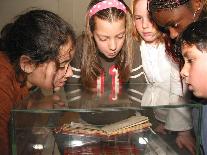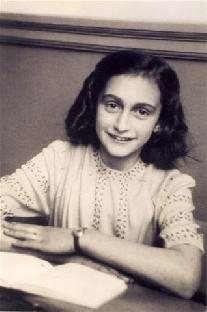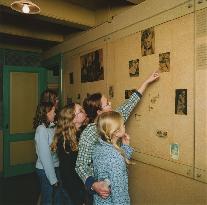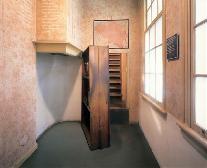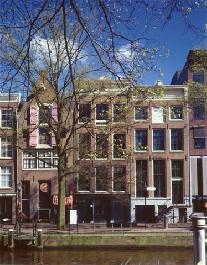EUROPE
Anne Frank House (The Netherlands)
(Oct. 1, 2009)
by Annemarie Bekker, Senior Employee, Communications Department
Annelies Marie Frank is born on June 12, 1929 in Frankfurt am Main, Germany. She is the second daughter of Otto Frank and Edith Frank-Holländer; Margot is their first daughter, born on February 16, 1926. The family is Jewish and German. At the beginning of 1933, the Nationalsozialistische Deutsche Arbeiterpartei (NSDAP or Nazi party) comes to power in Germany. Adolf Hitler, the leader of this party, becomes Chancellor. Before very long, there is discrimination against Jews. Germany changes from a democracy into a dictatorship. Anne's parents no longer feel safe. Otto and Edith Frank decide to leave Germany and go to the Netherlands in the summer of 1933.
The Frank Family feel free and safe, until the German Army invades the Netherlands on May 10, 1940. The Occupation of the Netherlands begins on May 15, 1940. The discrimination against the Jews begins then as well: Jews may not own their own businesses, Jewish children have to go to Jewish schools, all Jews have to wear a yellow star, and countless other restrictions. There are even rumors that the Jews will be packed off to German.
On June 12, 1942, Anne Frank celebrates her 13th birthday. She receives a diary as a present from her parents. It is her favorite gift. She begins writing in it immediately: "I hope I will be able to confide everything to you...and I hope you will be a great source of comfort and support." Just like thousands of other Jews living in Amsterdam, Margot Frank receives a call-up on July 5, 1942. The Nazis plan to send the people they have summoned to work camps in Germany. The entire family will be arrested if Margot does not report. The Frank family immediately leave for the hiding place in the back part of Otto Frank’s office building at 263 Prinsengracht. Naturally, Anne brings her diary. Much later, she will look back and write: "My happy-go-lucky, carefree school days are gone forever." Later on, Hermann and Auguste van Pels, their son Peter, and Fritz Pfeffer join the Frank family in hiding. The 8 people in hiding are helped by Otto Frank's four employees: Miep Gies, Johannes Kleiman, Victor Kugler and Bep Voskuijl. They arrange the food supplies, clothing, books, and all sorts of other necessities.
While business continues, as usual, in the front part of the building, there are people hiding in the annex out back. Before too long, the entrance to the Secret Annex is concealed behind a movable bookcase. In hiding, there is a lot of tension, probably due to the oppressive nature of the hiding place and their constant fear of being discovered. As often as she can, Anne pours out her heart to her diary: "The nicest part is being able to write down all my thoughts and feelings, otherwise I'd absolutely suffocate." For more than two years, Anne Frank lives secretively with the other people in hiding.
On Friday, August 4, 1944, suddenly, an SS-officer and three Dutch policemen enter the building and go directly to the office and the eight people in hiding are taken to Westerbork by passenger train. Because they did not report voluntarily, but have been arrested instead, they are assigned to barracks in the punishment block. On the morning of September 3, 1944, among the 1019 Jewish prisoners, the eight people from the Secret Annex are sent to Auschwitz-Birkenau. At the end of October 1944, Anne and her sister Margot are transported from Auschwitz-Birkenau to Bergen-Belsen. Anne and Margot succumb to typhus in March 1945, a few weeks before the camp is liberated by the British Army.
Otto Frank returns to Amsterdam as sole survivor. Otto finally withdraws from the company in 1953 and devotes more and more of his time to his daughter Anne's diary. He devotes himself to the preservation of the building. The adjacent buildings, however, are nominated for demolition. This forms a direct threat to #263. Furthermore, the building is in bad condition. Under pressure from public opinion and thanks to a collection initiated by the mayor of Amsterdam Van Hall, the building is saved.
The Secret Annex has been preserved in its authentic state and it became a museum in 1960. In the first year, no less than 9,000 people visited the museum. Ten years later there were 180,000 visitors. In 1990, when the visitors' numbers first exceeded 600,000, it became clear that the museum needed more space for its facilities. The aim to return the front part of the building at #263 Prinsengracht to its old historic condition also arose. In co-operation with the Amsterdam council, sponsors, architects, restorers, designers and contractors, a large project was initiated under the name “Preservation and the future of the Anne Frank House.” Eventually, Queen Beatrix opened the renewed museum on September 28, 1999.
The front part of the building--the offices where the helpers worked--has been restored to the style and ambiance of the war years. Quotations from the diary, photographs, films, and original objects--the pictures that Anne pasted on the wall paper in her room, the marks measuring the growth of Anne and her sister Margot, the Latin lessons of Margot, the prayer book of Edith, a Charles Dickens book that had been Otto's, and other items that belonged to the people in hiding and those who helped them--all serve to illustrate the events that occurred at this location. Anne's first diary, which was added to UNESCO's Memory of the World Register in July 2009, is also on display in the museum.
In the new wing of the museum is a multimedia space and an interactive exhibition on contemporary issues called Free2choose. This exhibition presents current examples, from around the world, of fundamental rights that clash with safeguarding the democratic rule of law and explores the present-day boundaries of freedom.
The history of Anne Frank House teaches us that freedom and democracy are inseparable. The citizens of every democratic society are guaranteed a number of fundamental rights under the law. These include, for instance, freedom of speech, religious freedom and the right to privacy. The Anne Frank House brings the life story of Anne Frank to the attention of people all over the world so they are challenged to think about the dangers of anti-semitism, racism and discrimination and the importance of freedom, equal rights and democracy.
Address: Prinsengracht 267 Amsterdam
Phone: +31- (0) 20- 5567100
Homepage: www.annefrank.org
Days closed: Closed on Yom Kippur. (In 2009, on September 28.)
Admission: Adults: 8.50€; Ages 10-17: 4.00€; Ages 0-9: free
(Originally published on Sept. 7, 2009)
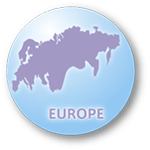 Peace Museums of EUROPE
Peace Museums of EUROPE
